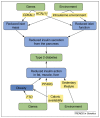Type 2 diabetes: new genes, new understanding
- PMID: 18952314
- PMCID: PMC7116807
- DOI: 10.1016/j.tig.2008.09.004
Type 2 diabetes: new genes, new understanding
Abstract
Over the past two years, there has been a spectacular change in the capacity to identify common genetic variants that contribute to predisposition to complex multifactorial phenotypes such as type 2 diabetes (T2D). The principal advance has been the ability to undertake surveys of genome-wide association in large study samples. Through these and related efforts, approximately 20 common variants are now robustly implicated in T2D susceptibility. Current developments, for example in high-throughput resequencing, should help to provide a more comprehensive view of T2D susceptibility in the near future. Although additional investigation is needed to define the causal variants within these novel T2D-susceptibility regions, to understand disease mechanisms and to effect clinical translation, these findings are already highlighting the predominant contribution of defects in pancreatic beta-cell function to the development of T2D.
Figures



References
-
- Stumvoll M, et al. Type 2 diabetes: principles of pathogenesis and therapy. Lancet. 2005;365:1333–1346. - PubMed
-
- Zimmet P, et al. Global and societal implications of the diabetes epidemic. Nature. 2001;414:782–787. - PubMed
-
- Sladek R, et al. A genome-wide association study identifies novel risk loci for type 2 diabetes. Nature. 2007;445:881–885. - PubMed
-
- Saxena R, et al. Genome-wide association analysis identifies loci for type 2 diabetes and triglyceride levels. Science. 2007;316:1331–1336. - PubMed
Publication types
MeSH terms
Grants and funding
LinkOut - more resources
Full Text Sources
Other Literature Sources
Medical
Miscellaneous

